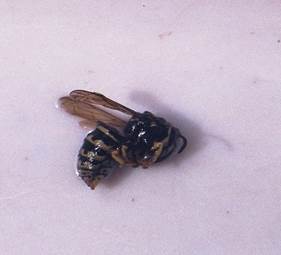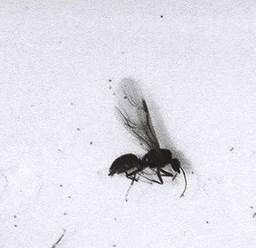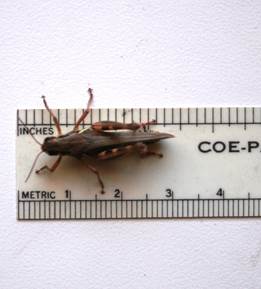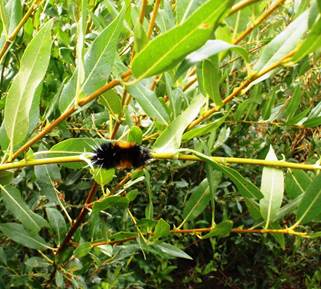TERRESTRIALS IN THE FILM ZONE (part 5)
| Sysadmin Note |
|---|
| Part Four can be found here |
Historically speaking anglers have been aware of the importance of terrestrial insect for a very long time. Now, if we examine the facts and apply a little bit of common sense we can clearly see how certain aspects of bait fishing was easily carried over to fly fishing. Many of the ancient anglers fished both bait and flies as the situation dictated. Now any bait angler of the day was surely aware of the terrestrial insects on the water and this knowledge was simply translated into fly fishing terms and terrestrials appeared in some of the earliest printed text printed on fly fishing.
As I have stated in many other selections that I have penned, the dry fly was the focus of the early anglers. In his 2013 volume entitled Fly Fishing Outside the Box, Emerging Heresies, author Peter Hayes offered an inspired explanation on Page 55.
"What Hills, whose review of the literature, A History of Fly Fishing for Trout, is excellent and well worth reading, failed to understand was that during the previous 350 years it was the angler's job to keep the fly floating—and not the job of the tackle."
Peter has made an excellent point and if you look at the history of fly fishing in this manner many historical facts become much easier to understand. Terrestrials appeared in the very first printed volume, which of course is without a doubt one of the most famous works in fly fishing history.
In 1496 Wynkyn de Word published The Boke of Saint Albans and this volume contained a selection entitled The Treatyse of Fysshynge wyth an Angle, and was authored by Dame Juliana Berners and her selection of twelve flies for the season are the Wasp Fly and the Shell Fly, both of which are terrestrial imitations. Furthermore, the main material ingredient of each of her flies was wool and at that time wool was infused with the natural floatant of lanolin.
The next major historical work that was published where terrestrial patterns were listed is found in the 5th Edition of Izaak Walton's The Compleat Angler, which contained Charles Cotton's Being Instructions How to Angle for A Trout or Grayling in a Clear Stream. Cotton developed several terrestrial patterns including the Peacock Fly which is a possible beetle imitation along with Green Grasshopper, The Little Dun Grasshopper, Wasp Fly, Red Ant, Black Ant, and the White Fly which may be a moth imitation and the Harry Long Legs.
Now these imitations were not developed because the anglers of the day noticed sunken terrestrial in the water, I believe that these flies were developed because anglers saw these insects on the water.
Over the years many authors have advanced our knowledge of terrestrial insects and their importance as trout food, however we are still locked within the traditions of the box we call the hatch. When we see a flight of ants, beetles or numbers of grasshopper or moths on the water we will turn to terrestrials.
However, when there are no major terrestrial events on the water we simply ignore the terrestrial patterns we carry in our fly boxes, however the trout see a wide variety of terrestrial insects on a daily basis and they seldom turn down an easy terrestrial meal.
Now, it is very important for the fly angler to remember that the terrestrial insects are land based insects and when they find themselves floating on the surface of the water we must understand that they will not float forever and that they will end up beneath the surface of the water.
Now for the purpose of this selection I will be talking about fishing the major terrestrial forms in the film zone, furthermore we will begin at the top of the film zone and work are way down.
Fishing Terrestrials on and in the Surface Film
Let us begin with flying ants. Each year anglers encounter flights of various sized ants on the waters that they fish and some anglers embraces these opportunities while others are made nervous by the size of the ants. However there are easy solutions for all of those problems, so let us begin.
It is kind of hard not to notice a major flight of flying ants during the hours of daylight but I remember years ago fishing a late evening spinner fall on DePuy's Spring Creek with Gary Borger. The spinner fall was fading and so was the light when suddenly the water was alive with rising fish and we both quickly dipped small nets in the water and found the water covered with tiny size 24 black flying ants.
Even though the light was fading we were able tie on reasonable imitations and take several more trout before the light totally failed and the ants disappeared from the water. Generally fly ants appear during the hours of daylight and when they land on the water it takes the trout only a minute or two to discover this tasty morsel on the water and begin to feed. What I recommend is for the angler to move as close as practical to the rising trout, sample the water to gain an understanding as to the size and color of the ants. Select a suitable imitation and grease the entire leader, and then select a casting or presentation angle that allows you to present the imitation properly to the trout and gives you the best angle of vision.
Short accurate casts allows for faster reaction to the feeding takes of the trout, furthermore short cast also allows for better line control. Now if you happen to be visually challenged as many of us are with the advance of time, you can tie on a larger fly that you can see and fish the small ant imitation behind on a dropper of approximately twenty inches.
Most ant imitations float both on the surface film and in the surface film and if your eyesight or the size of the ants allows you to see the imitations fish the surface imitation and follow that with a dropper of twelve inches and attach another ant imitation that is not greased and becomes submerged in or barely beneath the surface film.
During the event of the flying ants on the water I am always aware of back-eddies and the edges of the currents along the banks, especially those edge currents that flow over good trout holding water and as the numbers of fly ants begin to fade I begin to scan those areas for trout that are still feeding in an opportunistic manner on the ants.
On occasion the angler can also run into a large number of beetles on the water and the same methods can be used. During those days when all the variables line up and we find grasshoppers on the water in large numbers again dry and slightly wet imitation combinations are very effective.
Fishing Terrestrials beneath the Surface Film and at the Bottom of the Zone
During any ant flight of reasonable duration ants will begin to sink beneath the surface of the water due to the fact that they drowned or are drowned by wave and or wind action; regardless they do not float on the surface of the water forever.
This holds true of grasshopper, beetles, wasps or any number of terrestrials that find themselves on the water. Furthermore the trout are very aware of these sunken morsels and move to intercept this easy meal which is not trying to escape but rather is subject to the whims of the currents.
Fishing wet imitations beneath the surface of the water can be accomplished by using dry/wet combinations with the dropper length decided by the current speed of the water being fished. You can also use single wet imitations or a pair of wet imitations using tactics with or without a strike indicator.

Yellow Jacket

Black Beetle

Fly Black Ant

Grasshopper

Caterpillar
Further Tips on Fishing Terrestrials in the Film Zone
There are many times throughout the warm months of the fishing season that the fly angler can fish terrestrials in the film zone, some of these opportunities arise through the anglers ability to be observant. I remember an afternoon just a couple of years ago, it was August and the hatch of the day was over and as I head back downstream for a bite of lunch I came upon a section of the stream where there was a sharp angled turn to the left. Along the bank that was facing me I could see several good trout feeding tight to the bank, I move to get below the trout where I could sample the water as I could see nothing on the water on which the trout could be feeding.
It wasn't until I sampled the water tight to the bank was the questioned answered; there tight to the bank was a steady stream of leaf hoppers and the trout in that area were actively feeding on them. This feeding action was only going on along this one particular section of the stream. I had the proper imitation and was able to pick off three of these trout before the others spooked and stopped feeding. I pumped the stomachs of each of the captured trout and each was full of these small insect.
I recall another time, when I noticed several rising trout along a bank and up above me there was a log that was partially in the water and the water was littered with rather large ants. I quickly tied on a reasonable imitation and began to take some of those feeding trout, however I noticed several takes that I believed to be subsurface, I added another ant imitation tied to sink slightly beneath the surface and I had almost three hours of the most delightful fishing. Later I walked up to see what caused the bounty and discovered a large ant hill next to the fallen log which had been kicked by wildlife and the ants were out and about repairing their domain and many had wandered down the log to close to the water. Some were swept away by the surface currents, while other were being sucked under the log and the trout were feeding on both.
These happy events only happened because I am always observing what is happening on the water I am fishing!
I often use terrestrials to search the water, using an ant or beetle imitation and often will use dry/wet combinations to fish the edges along the stream. I have used this method at all hours of the day and have had success by searching the water with terrestrials in the film, on the surface film and within six inches of the surface.
We are often looking for hatches, while the trout are always looking for a meal.
Enjoy & Good Fishin'
